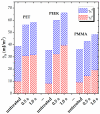Adhesion Properties and Stability of Polar Polymers Treated by Air Atmospheric Pressure Plasma
- PMID: 38891498
- PMCID: PMC11174711
- DOI: 10.3390/polym16111552
Adhesion Properties and Stability of Polar Polymers Treated by Air Atmospheric Pressure Plasma
Abstract
This study continues the discussion on the surface modification of polymers using an atmospheric pressure plasma (APP) reactor in air. These results complement prior research focusing on nonpolar polymers. Polymers, such as polyethylene terephthalate, polyetheretherketone, and polymethyl methacrylate, containing structurally bonded oxygen are studied, representing a range of properties such as oxygen content, crystalline/amorphous structure, polarity, functionality, and aliphatic/aromatic structure. APP induces superior wetting properties on the hydrophilic polymer surfaces with rapid and uniform modification within 0.5 s of exposure. The amorphous structures undergo additional modification for longer exposure. Moreover, the aliphatic chain structures require longer plasma exposure to reach surface modification equilibrium. The polar polymers reach a limit level of modification corresponding to a minimum water contact angle of about 50°. The surface polarity increases on average by a factor of approximately two. The equilibrium values of the adhesion work attained after post-processing recovery fall within a limited range of about 100-120 mJ/m2. The enhancement of surface functionality through the creation of oxidized groups primarily depends on the initial oxygen content and reaches a limit of about 40 at.% oxygen. The surface properties of the treated polar surfaces exhibit good stability, comparable to that of the previously tested nonpolar polymers.
Keywords: XPS; adhesion; atmospheric pressure plasma; contact angle; plasma treatment of polymers; polyetheretherketone; polyethylene terephthalate; polymethyl methacrylate.
Conflict of interest statement
The authors declare no conflicts of interest.
Figures






Similar articles
-
Discharge Energy Versus Exposure Time in Atmospheric-Pressure Air Plasma Surface Treatment of Polyimide and Polyamide 6 Films.Polymers (Basel). 2025 May 19;17(10):1394. doi: 10.3390/polym17101394. Polymers (Basel). 2025. PMID: 40430690 Free PMC article.
-
Adhesion Properties and Stability of Non-Polar Polymers Treated by Air Atmospheric-Pressure Plasma.Polymers (Basel). 2023 May 25;15(11):2443. doi: 10.3390/polym15112443. Polymers (Basel). 2023. PMID: 37299241 Free PMC article.
-
Protein adhesion and cell response on atmospheric pressure dielectric barrier discharge-modified polymer surfaces.Acta Biomater. 2010 Jul;6(7):2609-20. doi: 10.1016/j.actbio.2010.01.015. Epub 2010 Jan 21. Acta Biomater. 2010. PMID: 20096386
-
Surface Modification of Polyamides by Gaseous Plasma-Review and Scientific Challenges.Polymers (Basel). 2020 Dec 17;12(12):3020. doi: 10.3390/polym12123020. Polymers (Basel). 2020. PMID: 33348676 Free PMC article. Review.
-
Non-Equilibrium Plasma Methods for Tailoring Surface Properties of Polyvinylidene Fluoride: Review and Challenges.Polymers (Basel). 2021 Dec 3;13(23):4243. doi: 10.3390/polym13234243. Polymers (Basel). 2021. PMID: 34883744 Free PMC article. Review.
Cited by
-
Discharge Energy Versus Exposure Time in Atmospheric-Pressure Air Plasma Surface Treatment of Polyimide and Polyamide 6 Films.Polymers (Basel). 2025 May 19;17(10):1394. doi: 10.3390/polym17101394. Polymers (Basel). 2025. PMID: 40430690 Free PMC article.
References
-
- Bower D.I. An Introduction to Polymer Physics. Cambridge University Press; New York, NY, USA: 2002.
-
- Gautam K., Gogoi D., Kongnyui T.D., Devi S., Kumar C., Kumar M. A comprehensive review on surface modifications of polymer-based 3D-printed structures: Metal coating prospects and challenges. Polym. Adv. Technol. 2024;35:e6369. doi: 10.1002/pat.6369. - DOI
-
- Bertin M., Leitao E.M., Bickerton S., Johannes C., Verbeek R. A review of polymer surface modification by cold plasmas toward bulk functionalization. Plasma Process Polym. 2024;21:e2300208. doi: 10.1002/ppap.202300208. - DOI
LinkOut - more resources
Full Text Sources

